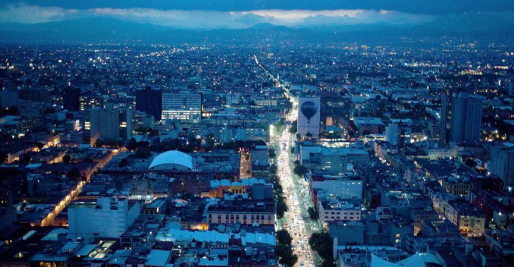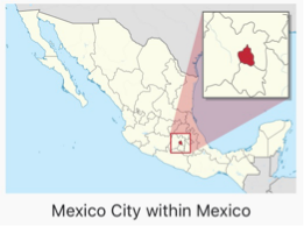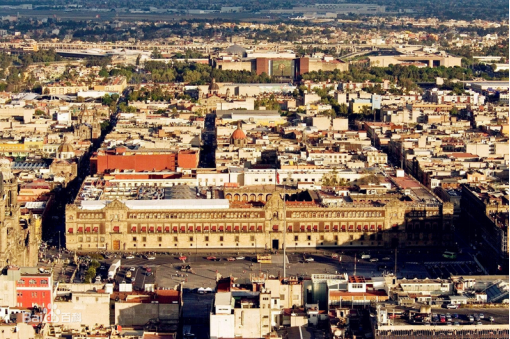Mexico City(Mexico) 作者: 来源: 发布时间:2021-06-02
1.Population and Area
Mexico City is the capital and largest city of Mexico and the most populous city in North America. It is located in the Valley of Mexico (Valle de México), a large valley in the high plateaus in the center of Mexico, at an altitude of 2,240 meters (7,350 ft). The 2009 population for the city proper was approximately 8.84 million people, with a land area of 1,485 square kilometers (573 sq mi).

2.Geography
Mexico City is located in the Valley of Mexico, sometimes called the Basin of Mexico. This valley is located in the Trans-Mexican Volcanic Belt in the high plateaus of south-central Mexico. It has a minimum altitude of 2,200 meters (7,200 feet) above sea level and is surrounded by mountains and volcanoes that reach elevations of over 5,000 meters (16,000 feet). This valley has no natural drainage outlet for the waters that flow from the mountainsides, making the city vulnerable to flooding. Drainage was engineered through the use of canals and tunnels starting in the 17th century.

Originally much of the valley lay beneath the waters of Lake Texcoco, a system of interconnected salt and freshwater lakes. The Aztecs built dikes to separate the fresh water used to raise crops in chinampas and to prevent recurrent floods. These dikes were destroyed during the siege of Tenochtitlan, and during colonial times the Spanish regularly drained the lake to prevent floods. Only a small section of the original lake remains, located outside Mexico City, in the municipality of Atenco, State of Mexico.
Architects Teodoro González de León and Alberto Kalach along with a group of Mexican urbanists, engineers and biologists have developed the project plan for Recovering the City of Lakes. If approved by the government the project will contribute to the supply of water from natural sources to the Valley of Mexico, the creation of new natural spaces, a great improvement in air quality, and greater population establishment planning.
3.Economy
Greater Mexico City has a GDP of $411 billion in 2011, making Greater Mexico City one of the most productive urban areas in the world. The city was responsible for generating 15.8% of Mexico's GDP, and the metropolitan area accounted for about 22% of total national GDP. If it were an independent country, in 2013, Mexico City would be the fifth-largest economy in Latin America, five times as large as Costa Rica and about the same size as Peru.
Mexico City is one of the most important economic hubs in Latin America. The city proper produces 15.8% of the country's gross domestic product. According to a study conducted by PwC, Mexico City had a GDP of $390 billion, ranking it as the eighth richest city in the world and the richest in Latin America. Mexico City alone would rank as the 30th largest economy in the world. Mexico City is the greatest contributor to the country's industrial GDP (15.8%) and also the greatest contributor to the country's GDP in the service sector (25.3%). Due to the limited non-urbanized space at the south—most of which is protected through environmental laws—the contribution of Mexico City in agriculture is the smallest of all federal entities in the country. Mexico City has one of the world's fastest-growing economies and its GDP is set to double from 2008 to 2020.
In 2002, Mexico City had a Human Development Index score of 0.915, identical to that of South Korea.
The top twelve percent of GDP per capita holders in the city had a mean disposable income of US$98,517 in 2007. The high spending power of Mexico City inhabitants makes the city attractive for companies offering prestige and luxury goods.
The economic reforms of President Carlos Salinas de Gortari had a tremendous effect on the city, as a number of businesses, including banks and airlines, were privatized. He also signed the North American Free Trade Agreement (NAFTA). This led to decentralization and a shift in Mexico City's economic base, from manufacturing to services, as most factories moved away to either the State of Mexico, or more commonly to the northern border. By contrast, corporate office buildings set their base in the city.
4. Industry
Mexico City is the center of a manufacturing belt that stretches from Guadalajara in the west to Veracruz on the Gulf of Mexico in the east. Manufactures include textiles, chemicals and pharmaceuticals, electrical and electronic items, steel, and transportation equipment. In addition, a variety of foodstuffs and light consumer goods are produced.
The city plays a dominant role in Mexico’s banking and finance industries. It is home to Banco de México (federal reserve bank), the Bolsa (stock exchange), and every major banking chain in the country. All major financial services, including insurance companies, are centered in Mexico City.
Agriculture, mining, and trade dominated Mexico City’s economy for most of its history. An industrial economy began to take root in the early 1900s. However, industry did not become the leading economic activity until government investment programs encouraged large-scale growth of manufacturing and other industrial production in the city in the 1940s and 1950s.
During the 1980s, however, the government began to encourage industrial and manufacturing development in other areas of the country in an attempt to reduce pollution and overcrowding in the city. These attempts led to the decline of industrial production and employment in the city. From 1980 to 1988, Mexico City lost almost 100,000 (about 25 percent) of its industrial jobs. Although the city has lost industrial and manufacturing jobs, other sectors of its economy, notably services and commerce, have grown.
The concentration of economic activity in the city attracted people from rural areas in search of employment. People moved to the city faster than new jobs were created. Many of these new residents of Mexico City were unskilled workers. They were unable to find employment in the city, contributing to problems of unemployment and underemployment.
5.Tourism

Mexico City is a destination for many foreign tourists. The Historic center of Mexico City (Centro Histórico) and the "floating gardens" of Xochimilco in the southern borough have been declared World Heritage Sites by UNESCO. Landmarks in the Historic Center include the Plaza de la Constitución(Zócalo), the main central square with its epoch-contrasting Spanish-era Metropolitan Cathedral and National Palace, ancient Aztec temple ruins Templo Mayor ("Major Temple") and modern structures, all within a few steps of one another. (The Templo Mayor was discovered in 1978 while workers were digging to place underground electric cables).
The most recognizable icon of Mexico City is the golden Angel of Independence on the wide, elegant avenue Paseo de la Reforma, modeled by the order of the Emperor Maximilian of Mexico after the Champs-Élysées in Paris. This avenue was designed over the Americas' oldest known major roadway in the 19th century to connect the National Palace (seat of government) with the Castle of Chapultepec, the imperial residence. Today, this avenue is an important financial district in which the Mexican Stock Exchange and several corporate headquarters are located. Another important avenue is the Avenida de los Insurgentes, which extends 28.8 km (17.9 mi) and is one of the longest single avenues in the world.
Chapultepec Park houses the Chapultepec Castle, now a museum on a hill that overlooks the park and its numerous museums, monuments and the national zoo and the National Museum of Anthropology (which houses the Aztec Calendar Stone). Another piece of architecture is the Palacio de Bellas Artes, a white marble theatre/museum whose weight is such that it has gradually been sinking into the soft ground below. Its construction began during the presidency of Porfirio Díaz and ended in 1934, after being interrupted by the Mexican Revolution in the 1920s. The Plaza de las Tres Culturas, in this square are located the College of Santa Cruz de Tlatelolco, that is the first and oldest European school of higher learning in the Americas, and the archaeological site of the city-state of Tlatelolco, and the shrine and Basilica of Our Lady of Guadalupe are also important sites. There is a double-decker bus, known as the "Turibus", that circles most of these sites, and has timed audio describing the sites in multiple languages as they are passed.
In addition, according to the Secretariat of Tourism, the city has about 170 museums—is among the top ten of cities in the world with highest number of museums—over 100 art galleries, and some 30 concert halls, all of which maintain a constant cultural activity during the whole year. It has either the third or fourth-highest number of theatres in the world after New York, London and perhaps Toronto. Many areas (e.g. Palacio Nacional and the National Institute of Cardiology) have murals painted by Diego Rivera. He and his wife Frida Kahlo lived in Coyoacán, where several of their homes, studios, and art collections are open to the public. The house where Leon Trotsky was initially granted asylum and finally murdered in 1940 is also in Coyoacán.

6.History
Mexico's capital is both the oldest capital city in the Americas and one of two founded by indigenous people, the other being Quito, Ecuador. The city was originally built on an island of Lake Texcoco by the Aztecs in 1325 as Tenochtitlan, which was almost completely destroyed in the 1521 siege of Tenochtitlan and subsequently redesigned and rebuilt in accordance with the Spanish urban standards. In 1524, the municipality of Mexico City was established, known as México Tenochtitlán, and as of 1585, it was officially known as Ciudad de México (Mexico City). Mexico City was the political, administrative, and financial center of a major part of the Spanish colonial empire. After independence from Spain was achieved, the federal district was created in 1824.
After years of demanding greater political autonomy, residents were finally given the right to elect both a head of government and the representatives of the unicameral Legislative Assembly by election in 1997. Ever since, left-wing parties (first the Party of the Democratic Revolution and later the National Regeneration Movement) have controlled both of them. The city has several progressive policies, such as abortionon demand, a limited form of euthanasia, no-fault divorce, and same-sex marriage.
On 29 January 2016, it ceased to be the Federal District (Spanish: Distrito Federal or D.F.) and is now officially known as Ciudad de México (or CDMX), with a greater degree of autonomy. A clause in the Constitution of Mexico, however, prevents it from becoming a state within the Mexican federation, as it is the seat of power in the country, unless the capital of the country were to be relocated elsewhere.
7.Other information
As the centre of the ancient Aztec Empire and the seat of power for the Spanish colony of New Spain, The historic center of Mexico City contains most of the city's historic sites from both eras as well as a large number of museums. This has made it a World Heritage Site.
8.Contact
Address: Plaza de la Constitución 2, Alcaldía Cuauhtémoc, Centro, C.P.06068,Ciudad de México
E-mail: multimediagdf@cdmx.gob.mx
Facebook: Gobierno de la Ciudad de México
Website: https://www.cdmx.gob.mx/
Mayor: Claudia Sheinbaum
